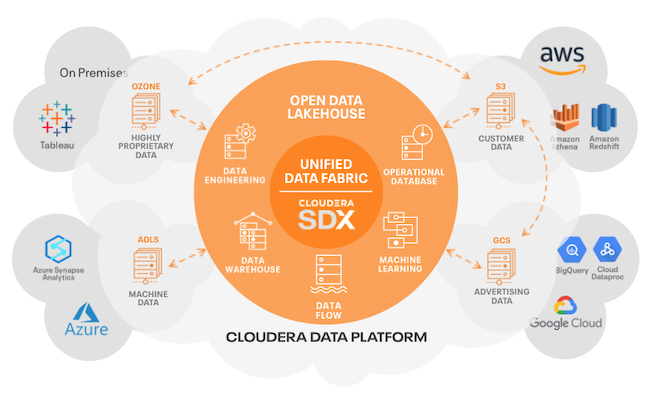Cloudera CEO Charles Sansbury and other executives took to the stage at Cloudera Evolve 2024 APAC being held in Singapore this week, to announce new product offerings, share customer stories, and talk about the company's growth.
A continual, recurring theme of the event was how vast the Cloudera customer base is, and the enormous scale of data being managed by the platform. In fact, Sansbury said, the company brings in more than a billion USD in revenue, is used across the top global 2000 customers including eight out of 10 banks, and has over 25 exabytes of data under management.
"That's more data than any other company in the world," Sansbury said, pictured below.

|
|
An exabyte is 1,000,000,000,000,000,000 bytes. We can relate to a terabyte - that's 1000 gigabytes, which in turn is 1000 megabytes. We have disk drives measured in terabytes now. Well, 1000 terabytes is called a petabyte. And an exabyte is 1000 petabytes. Some people say all the words ever spoken by humanity would sum to 5 exabytes. And Cloudera manages more than five times that much.
It's so much data that Sansbury says some of Cloudera's customers - a subset of that 25 exabytes - have more data individually than all the data contained by some of the public cloud hyperscalers across all their customers combined.
Obviously then, Cloudera is not itself using those hyperscalers as its backbone for data. Well, not completely. What's going on here is that Cloudera is a hybrid platform - in fact, Sansbury says it is the only true hybrid platform - working with customer data wherever it may be. Some data may be on-premises, some on this cloud, some on that cloud. No matter where your data is, Cloudera believes you should own and govern your own data, not vendors. Its products and tools will seamlessly accomodate. As such, Cloudera can be deployed in your own environment or on a public cloud, even multiple public clouds.

Cloudera is a billion dollar company today, but it was not always the case. The business began life in June 2008 by a team of Google, Yahoo!, and Facebook engineers, and an Oracle database executive, later being joined by a Hadoop co-founder the following year. Originally, Cloudera offered a free product based on Hadoop with revenue based on support and consulting. This morphed into a commercial Hadoop distribution. From 2009 to 2011 the company received $US 70 million of investment funding. In 2014 Cloudera raised another $US 160m from investors and a whopping $US 740m from Intel in exchange for an 18% stake of the company. It is almost a history lesson in the rise of analytics and big data and the role Hadoop played at the time.
Yet, the story changed as public cloud services emerged. As you might expect in the typical Silicon Valley journey, Cloudera went public in 2017 only to find its share price drop due to falling sales and stiff competition from public cloud services like AWS. Intel sold back its 18% ownership for less than half what it paid, $US 314m, in 2020.
As Cloudera rose to the challenge of differentiating itself - and strategically foresaw the valuable role of open source table formats like Iceberg, as well as the shift from all-in on public cloud to hybrid multi-cloud. Cloudera proved to be prescient on these and in late 2021 went private after an all-cash acquisition by KKR and Clayton, Dubilier and Rice. Today, Cloudera remains as a public company, but states it has over one billion USD in revenue, and is profitable to the tune of hundreds of millions. Meanwhile, other prominent data platform products are now rapidly embracing Iceberg also, while businesses globally are seeking to reduce their cloud bills by moving workloads to more appropriate locations, which might include on-premises but could be other clouds. In short, the trends Cloudera foresaw have come to pass, and Cloudera finds itself in a strong position to assist organisations of all sizes in their data and AI journey, especially as a first mover in adopting Iceberg as central and native to its platform.
It's some distance from Cloudera's roots as sifting through huge stores of corporate information to a major player helping customers prepare their data for AI purposes, be they tightly regulated financial industries, or industries with significant security, privacy, and sovereignty requirements, or even simply any company that wants to be more efficient with its spending while still achieving its goals.
In fact, one Cloudera customer who most definitely has security front-of-mind is the Australian Federal Police, who were named Cloudera's ANZ Customer of the Year during the event.
The drive to infuse, embed, and leverage AI is now so great that it is projected to add a huge 15.7 trillion US dollars to the global economy by as soon as 2030.
Yet, wanting to do AI is different from doing AI. And having data is most definitely different from having prepared and organised and governed data that's ready to use.
Sansbury has previously likened the AI journey to a field; you want to plant crops but boy, there's a lot of work that goes before it. You must plow the field into all kinds of nice rows. But there's dirt to shift, there are rocks to remove, you may need to boost soil and nutrients. Finally, your field is prepared. Only then can you plant crops and expect great results.
So too with data; Cloudera conducted research that formed the basis for its state of enterprise AI and modern data architecture report, revealing the top barriers to AI adoption presently are security and compliance concerns, lack of training and skills to manage AI, and the sheer cost of AI adoption itself.

Even so, ignore AI at your peril. “The gap between businesses leveraging AI and those lagging behind is widening rapidly,” said Cloudera SVP APJ Remus Lim, pictured above.
Here's where Cloudera comes in; the product is no mere database but a platform that, using Sansbury's analogy, helps you plow your field and get your rows lined up ready for planting, by assisting you in ensuring a strong data foundation.
“The need for a strong data foundation has never been clearer," Lim said. "AI is the key that unlocks the true potential of this valuable asset, but it is just the first step. In fact, our recent survey showed that 88% of enterprises are adopting AI in some capacity. However, organisations are seeking greater support in terms of data infrastructure and skills to operationalize their AI and access all of their data such that critical insights are trustworthy and unbiased; only then will the truly transformative impact of AI be seen.”
And, by embracing hybrid multi-cloud and working with your data where it resides, Cloudera can eliminate much of the bulky cost of shifting data to, and storing it in, public clouds.
"Cloudera is the only true hybrid platform for data analytics and AI. We enable global enterprises to use data to solve the impossible today," Lim said.











































